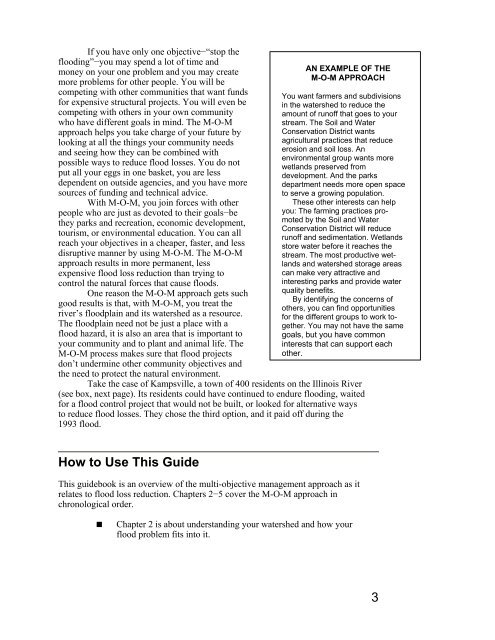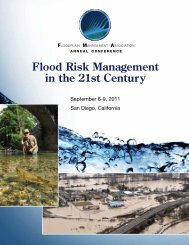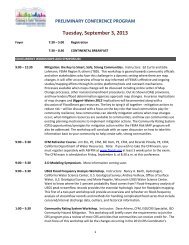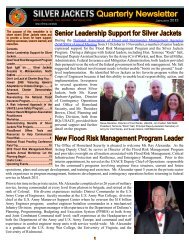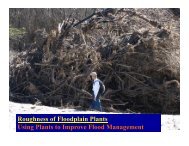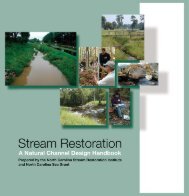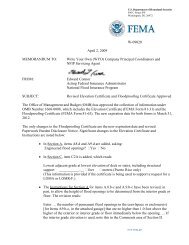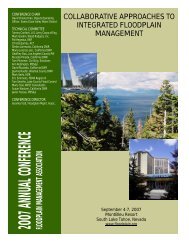Using Multi-Objective Management to Reduce Flood Losses in Your
Using Multi-Objective Management to Reduce Flood Losses in Your
Using Multi-Objective Management to Reduce Flood Losses in Your
Create successful ePaper yourself
Turn your PDF publications into a flip-book with our unique Google optimized e-Paper software.
If you have only one objective−“s<strong>to</strong>p the<br />
flood<strong>in</strong>g”−you may spend a lot of time and<br />
money on your one problem and you may create<br />
more problems for other people. You will be<br />
compet<strong>in</strong>g with other communities that want funds<br />
for expensive structural projects. You will even be<br />
compet<strong>in</strong>g with others <strong>in</strong> your own community<br />
who have different goals <strong>in</strong> m<strong>in</strong>d. The M-O-M<br />
approach helps you take charge of your future by<br />
look<strong>in</strong>g at all the th<strong>in</strong>gs your community needs<br />
and see<strong>in</strong>g how they can be comb<strong>in</strong>ed with<br />
possible ways <strong>to</strong> reduce flood losses. You do not<br />
put all your eggs <strong>in</strong> one basket, you are less<br />
dependent on outside agencies, and you have more<br />
sources of fund<strong>in</strong>g and technical advice.<br />
With M-O-M, you jo<strong>in</strong> forces with other<br />
people who are just as devoted <strong>to</strong> their goals−be<br />
they parks and recreation, economic development,<br />
<strong>to</strong>urism, or environmental education. You can all<br />
reach your objectives <strong>in</strong> a cheaper, faster, and less<br />
disruptive manner by us<strong>in</strong>g M-O-M. The M-O-M<br />
approach results <strong>in</strong> more permanent, less<br />
expensive flood loss reduction than try<strong>in</strong>g <strong>to</strong><br />
control the natural forces that cause floods.<br />
One reason the M-O-M approach gets such<br />
good results is that, with M-O-M, you treat the<br />
river’s floodpla<strong>in</strong> and its watershed as a resource.<br />
The floodpla<strong>in</strong> need not be just a place with a<br />
flood hazard, it is also an area that is important <strong>to</strong><br />
your community and <strong>to</strong> plant and animal life. The<br />
M-O-M process makes sure that flood projects<br />
don’t underm<strong>in</strong>e other community objectives and<br />
the need <strong>to</strong> protect the natural environment.<br />
AN EXAMPLE OF THE<br />
M-O-M APPROACH<br />
You want farmers and subdivisions<br />
<strong>in</strong> the watershed <strong>to</strong> reduce the<br />
amount of runoff that goes <strong>to</strong> your<br />
stream. The Soil and Water<br />
Conservation District wants<br />
agricultural practices that reduce<br />
erosion and soil loss. An<br />
environmental group wants more<br />
wetlands preserved from<br />
development. And the parks<br />
department needs more open space<br />
<strong>to</strong> serve a grow<strong>in</strong>g population.<br />
These other <strong>in</strong>terests can help<br />
you: The farm<strong>in</strong>g practices promoted<br />
by the Soil and Water<br />
Conservation District will reduce<br />
runoff and sedimentation. Wetlands<br />
s<strong>to</strong>re water before it reaches the<br />
stream. The most productive wetlands<br />
and watershed s<strong>to</strong>rage areas<br />
can make very attractive and<br />
<strong>in</strong>terest<strong>in</strong>g parks and provide water<br />
quality benefits.<br />
By identify<strong>in</strong>g the concerns of<br />
others, you can f<strong>in</strong>d opportunities<br />
for the different groups <strong>to</strong> work <strong>to</strong>gether.<br />
You may not have the same<br />
goals, but you have common<br />
<strong>in</strong>terests that can support each<br />
other.<br />
Take the case of Kampsville, a <strong>to</strong>wn of 400 residents on the Ill<strong>in</strong>ois River<br />
(see box, next page). Its residents could have cont<strong>in</strong>ued <strong>to</strong> endure flood<strong>in</strong>g, waited<br />
for a flood control project that would not be built, or looked for alternative ways<br />
<strong>to</strong> reduce flood losses. They chose the third option, and it paid off dur<strong>in</strong>g the<br />
1993 flood.<br />
How <strong>to</strong> Use This Guide<br />
This guidebook is an overview of the multi-objective management approach as it<br />
relates <strong>to</strong> flood loss reduction. Chapters 2−5 cover the M-O-M approach <strong>in</strong><br />
chronological order.<br />
<br />
Chapter 2 is about understand<strong>in</strong>g your watershed and how your<br />
flood problem fits <strong>in</strong><strong>to</strong> it.<br />
3


